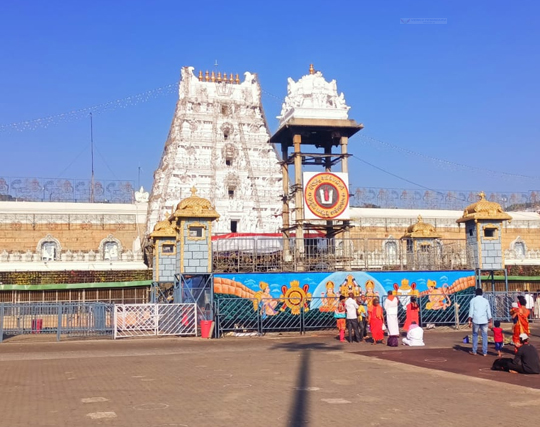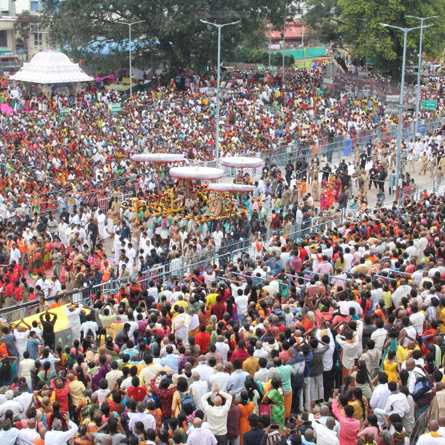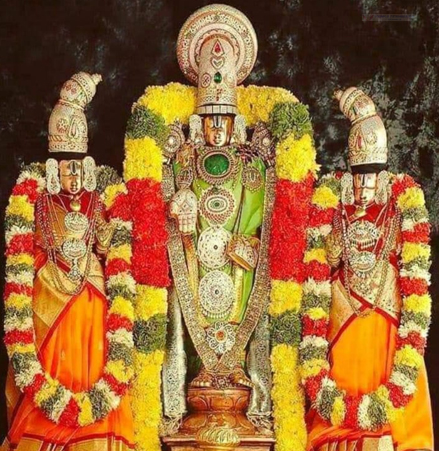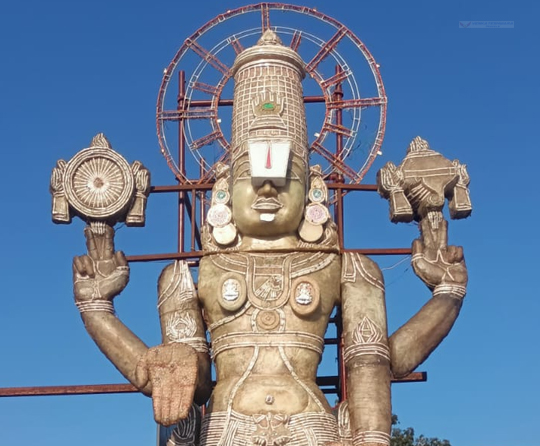Main Deity
Lord Sri Venkateswara is enshrined in Ananda Nilayam, the Sanctum Sanctorum, revered by all devotees and worshipped daily.

In the age of Kali, an intriguing myth recounts how Lord Vishnu appeared on Earth to bless his devotees. Sage Brighu, aiming to determine the supreme deity among the Holy Trinity, first questioned Lord Brahma and Lord Shiva but remained unsatisfied. He then went to Vaikuntha and, in an act of provocation, kicked Lord Vishnu on his chest. Goddess Lakshmi, who resided there, felt deeply insulted and decided to leave Vaikuntha. She descended to Earth, setting the stage for a series of divine interventions and blessings for the devotees. This event highlights the profound relationship between the divine and earthly realms.

In a story of divine love, Lord Vishnu, heartbroken over the separation from his consort Mahalakshmi, sought her out. She had reincarnated as Padmavati, the princess of a king. To be near her, Vishnu meditated within an anthill. Lord Shiva and Brahma, in the forms of a cow and calf, nourished him daily with milk. Their efforts led to the divine union of Vishnu (Venkateshwara) and Padmavati. To celebrate this union, Vishnu received a generous sum from Kuber, the wealth god, facilitating a magnificent wedding. Vishnu then settled on Tirumala hills, where a grand temple was built. It is believed that Vishnu repays Kuber's loan with the help of devotees.


The construction of the Tirupati Balaji Temple commenced around 300 AD, with significant contributions from various emperors and kings throughout history. In the 18th century, Maratha General Raghoji I Bhonsale established a permanent administration to manage the temple's affairs. This initiative led to the creation of the TIRUPATI TIRUMALA DEVASTHANAM (TTD), an administrative body formed under the TTD Act of 1933. The TTD oversees the temple's management and maintenance, ensuring the upkeep of not only the main shrine but also its associated sub-shrines. This structured administration has been crucial in preserving the temple's heritage and facilitating its operations through the decades.
| S.No | Aspect | Details |
|---|---|---|
| 1 | Lamp's Light | The lamp before the deity’s idol never extinguishes, symbolizing enduring devotion. |
| 2 | Idol Placement | The idol is positioned at the right-hand corner of the shrine, not at the center. |
| 3 | Ladoo Tag | In 2009, the ladoos served as Prashad received a Geographical Indication tag for their unique taste and cost. |
| 4 | Vijayanagara Empire Gifts | The shrine was gifted diamonds and gold by the Vijayanagara empire, with contributions from various emperors. |
| 5 | First Temple Construction | Linked to King Thondaiman, who dreamed of Lord Vishnu and decided to build the temple. |
| 6 | Moist Idol Back | The back of the idol remains moist, cleaned daily with a silk cloth. |
| 7 | Flower Disposal | Flowers offered during puja are discarded into waterfalls behind the idol. |
| 8 | Sound of Sea Waves | Listening closely to the idol’s back reveals the sound of enormous sea waves. |
| 9 | Offering Source | Items for puja are sourced from a secret village, unknown and unvisited by outsiders. |
| 10 | Visitor Statistics | Tirupati Balaji is among India’s richest and most visited temples, attracting 75,000 to 90,000 pilgrims daily. |
| 11 | COVID-19 Impact | The shrine has been closed for darshan for the past two months due to COVID-19, affecting pilgrim attendance. |
Tirupati Balaji Temple is renowned for its unique features. The idol’s real hair, never tangled, was gifted by a princess. It stands slightly off-center in the sanctum, while a perpetual lamp has burned for centuries. After Abhishekam, the idol's sweat is wiped with silk. The temple, one of India’s richest, receives daily offerings worth millions. Its ladoos, awarded a Geographical Indication tag in 2009, are uniquely revered. The idol reportedly emits ocean-like sounds, and offerings come from a secret village. The temple, built around 300 AD, is adorned with historical engravings and considered one of the eight Vishnu Swayambhu Kshetras. Its silk attire is funded by devotees, and nearby hills have symbolic shapes, adding to its mystique.

Yes, visitors are welcome to offer prayers and perform rituals according to customs.
Typically, darshan lasts between 20 to 30 minutes for visitors.
No, entry to the temple is entirely free for all devotees.
Yes, maintaining silence and refraining from photography inside the temple is essential.
While no strict dress code is enforced, visitors are advised to dress modestly.
Yes, the temple provides convenient facilities for elderly and differently-abled visitors.
No, outside food and drinks are generally not allowed within the temple premises.
Yes, there are parking facilities nearby for visitors' convenience.
The temple is open daily from 7:30 am to 8:30 pm.
Yes, several hotels and lodges are available nearby for overnight stays.

